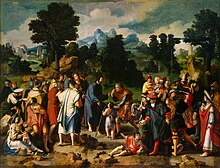Lucas van Leyden
Carel van Mander characterizes Lucas as a tireless artist, who as a child annoyed his mother by working long hours after nightfall, which she forbade not only for the cost of candlelight, but also because she felt that too much study was bad for his sensibilities.
Where he learnt engraving is unknown, but he took advantage of the works of Marcantonio Raimondi, whose motifs are reworked in Lucas' engravings and paintings, and became highly skilled in that art at a very early age: the earliest known print by him (Mohammed and the Murdered Monk) dates from 1508, when he was perhaps only 14, yet reveals no trace of immaturity in inspiration or technique.
Seventeen paintings surely by Lucas survive, and a further twenty-seven are known from descriptions by Carel van Mander, from contemporary copies or from drawings of them made by Jan de Bisschop in the later 17th century.
[1] Max Friedländer described no clear pattern of stylistic development, in large part because Lucas' oeuvre was swelled and obscured by attributions since found unsustainable.
[3] Four broad stages in his artistic development are characterized by Elise Lawton Smith as his early half-length figures (c 1506–1512), the development of his landscapes (c 1512–1520), the influence of Antwerp paintings (c 1521–25) and the late works (ca 1525–1531), where multiple figures are deployed against wooded landscapes, as in the Healing of blind man of Jericho (illustration).
Dürer's mastery of engraving and Gossaert's Romanist style both heavily influenced van Leyden's work.
From 1513 to 1517, Lucas created a series of woodcuts called "The Power of Women", which consisted of two large and small sets of prints.
[5] The series is one of a number of representations of the Power of Women theme, which was extremely popular in Renaissance art and literature.
[11] The Fall of Man: In the foreground, Adam and Eve are around the tree of knowledge of good and evil, with the serpent wrapped around the trunk and holding an apple.
King Solomon kneels in front of an idol of Moloch in the center foreground while one of his mistresses and a crowd of men observe him from behind.







